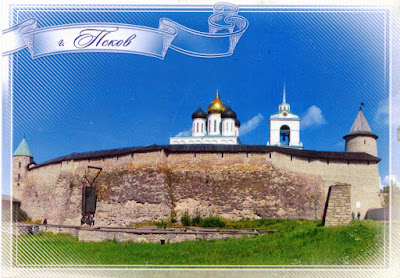 |
| 2066 Pokrovskaya (Intercession) Tower of Pskov Kremlin and Trinity Cathedral |
Located on the Velikaya River, about 20km east from the Estonian border, Pskov is one of the oldest cities in Russia, its earliest mention coming from 903, when Igor of Kiev married a local lady, St. Olga. In the 12th and 13th centuries, the town adhered politically to the Novgorod Republic. In 1241 it was taken by the Teutonic Knights, but Alexander Nevsky recaptured it several months later. In order to secure their independence from the knights, in 1266 the Pskovians elected a Lithuanian prince, Daumantas (known in Russia as Dovmont), as military leader and prince.
 |
| 1356 Pskov Kremlin and Trinity Cathedral |
Having fortified the town (the core of the citadel, erected by him, still bears his name), Daumantas routed the Teutonic Knights at Rakvere and overran much of Estonia. By the 14th century, the town functioned as the capital of a de facto sovereign republic, mainly due to the merchants who brought it into the Hanseatic League. For Russia, it was a bridge towards Europe; and for Europe a western outpost of Russia. Importance of the city made it a subject of numerous sieges throughout its history (26 in the 15th century alone).
A local school of icon-painting flourished, and local masons were considered the best in Russia. Many peculiar features of Russian architecture were first introduced in Pskov. In 1510 the city fell to Muscovite forces. As the second largest city of the Grand Duchy of Moscow, Pskov still attracted enemy armies. Peter the Great's conquest of Estonia and Latvia during the Great Northern War in the early 18th century spelled the end of Pskov's traditional role as a vital border fortress and a key to Russia's interior.
Even if under Soviet government many ancient buildings were demolished, and during WWII it suffered substantial damage, it still preserves much of its medieval walls, built from the 13th century. Its medieval citadel is called either the Krom or the Kremlin. Within its walls rises the 78m-tall Trinity Cathedral, founded in 1138, but destroyed and rebuilt several times over the centuries, last time in 1690. The cathedral contains shrines to two 13th century heroes of Pskov, Ss Vsevolod-Gabriel (died in 1138), the first prince of Pskov, and Prince Dovmont (died in 1299).
In 2019, ten monuments of religious architecture, churches and cathedrals, as well as, in some cases, part of the monastic structures around these, but also some elements of the fortress were included among UNESCO WHS under the name The Churches of the Pskov School of Architecture. It is one of the most influential Russian Schools of architecture, which fostered continuous exchange of ideas and characterized the development of architectural styles in Russia over five centuries, leading to specific architectural and decorative references.
Characteristics of these buildings include cubic volumes, domes, porches and belfries, with the oldest elements dating back to the 12th century. Churches and cathedrals are integrated into the natural environment through gardens, perimeter walls and fences. Inspired by the Byzantine and Novgorod traditions, the Pskov School of Architecture reached its peak in the 15th and 16th centuries, and was one of the foremost schools in the country. It informed the evolution of Russian architecture over five centuries.
About the stamps
On the postcard 1356
The first stamp, depicting Kolomna Kremlin (2.50 RUB), is part of a series dedicated to Russian Kremlins, about which I wrote here.
The last stamp was issued on April 26, 2013 for Europa Stamps 2014, with the theme Musical instruments - national musical instruments.
On the postcard 2066
The first stamp, depicting even Pskov Kremlin (6.00 RUB), is part of a series dedicated to Russian Kremlins, about which I wrote here. The second stamp is part of a set of four, issued in 2004 to mark the 200 birth anniversary of Mikhail Ivanovich Glinka (1804-1857). Mikhail Ivanovich Glinka was the first Russian composer to gain wide recognition within his own country, and is often regarded as the fountainhead of Russian classical music. The set is part of the series Opera (end of series). The last stamp is also part of a set of four, Arts and Crafts of Russia - Ceramic Tiles from Yaroslavl, designed by H. Betredinova and issued on August 4, 2015, part of a series depicting Arts and Crafts of Russia.
References
Pskov - Wikipedia
The Churches of the Pskov School of Architecture - UNESCO official website
Trinity Cathedral (Pskov, Russia) - Orthodox Wiki
Sender 1356, 2066: Olga Dorogova
Sent from Pskov (Pskov Oblast / Russia), on 20.10.2014
Sent from Pskov (Pskov Oblast / Russia), on 12.11.2015



No comments:
Post a Comment